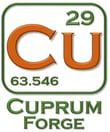FAQs
- Where does the name CUPRUM come from?
Cuprum is the Latin word for copper, and since I got my start in the metal arts making bracelets from reclaimed copper pipe, it just made sense. The logo (and my touchmark) is the symbol for copper from the Periodic Table of Elements.
- Do you accept commissions?
Yes! But please bear in mind, this is just a part-time hobby of mine, so completing your piece may take some time, or it may happen very, very fast. I do my best and appreciate your understanding and patience!
- You don't have a lot of items on the website. Do you have pieces for sale?
Sometimes. A lot of what I do is by commission - mostly for friends or friends of friends and that sort of thing. Occasionally I make a few things or have a few things laying around that are available for sale. When I do, I will post them here. Follow my facebook page to keep up with the latest things I'm working on! Cuprum Forge on Facebook
- How do I care for my copper utensils?
Hand wash only. Dry immediately with a soft dry cloth.
Copper will develop a patina over time, becoming a lustrous brown. To maintain a bright ‘coppery’ color finish, please polish with Wright's Copper Cream, available at most grocery stores in the household cleaning aisle.
Any brass parts on your Cuprum pieces may also be safely polished with Wrights Copper Cream.
Any light scratches may be buffed out by hand using fine steel wool. Steel wool comes in multiple grades – from coarse to very fine. Please use the ‘0000’ grade (the finest).
Any steel parts are treated against rust using wax. Waxing steel to prevent rust is a traditional blacksmithing method going back centuries. If the part develops a light rust, clean with ‘0000’ steel wool, wipe clean. Heat the piece in the oven to around 300 degrees and lightly wipe with a cloth and wax (floor wax will do). Buff any excess off.
- How do I care for my copper jewelry?
Copper will develop a patina over time, becoming a lustrous brown. To a bright ‘coppery’ color finish, please polish with Wright's Copper Cream, available at most grocery stores in the household cleaning aisle.
- How do I care for my silver jewelry?
To maintain a lustrous shine, please polish with Wright's Silver Cream, available at most grocery stores in the household cleaning aisle.
- How do I care for my knives?
Hand wash only. Dry immediately with a soft dry cloth.
I make steak knives from reclaimed, worn out saw blades. The type of steel is not precisely known, but it is of some form of high carbon steel alloy. As such, it will react to acidic foods and begin to develop a patina of splotchy ‘spots’ along the blade. This is normal for high-carbon steels and not avoidable (this is why most place setting knives are made from stainless steel). The patina can be allowed to develop over time, or the bright finish can occasionally be restored by sanding gently with 800 grit or higher sandpaper or a medium or fine 3M Scotchbrite pad.
When not in use for an extended period, apply a thin coat of any plant-based cooking oil to the blades to prevent rust. (E.g. olive oil, canola oil, vegetable oil, etc.)
Any light scratches may be buffed out by hand using fine steel wool. Steel wool comes in multiple grades – from coarse to very fine. Please use the ‘0000’ grade (the finest). If the steel wool does not do the trick, use 800 grit or higher sandpaper or a medium to fine 3M Scotchbrite pad.
Sharpen as you would any other fine knife.
